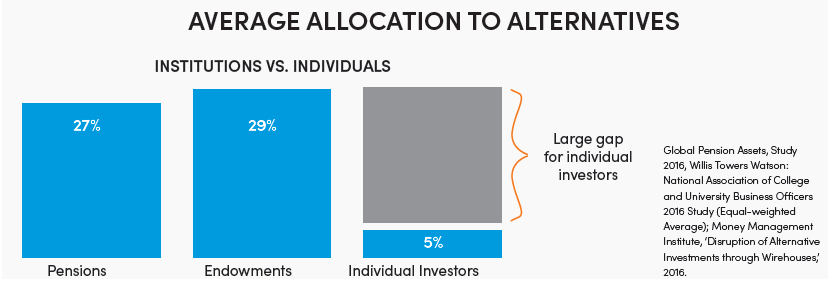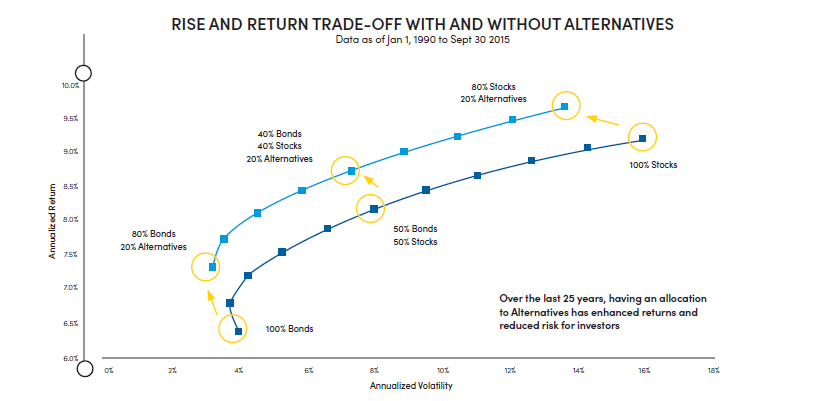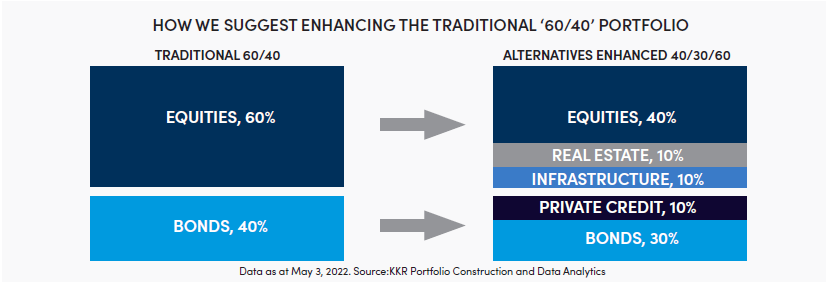The Case for Alternatives: Diversifying Portfolio Asset Allocation
Take outs:
-
While traditional asset classes like stocks and bonds have long been the cornerstone of investment portfolios, the landscape is evolving, with investors increasingly turning to alternatives to enhance diversification and potentially boost returns.
-
In Wealth Management, Alternative Investments refer to asset classes besides the traditional equities, fixed income and cash. These may include real estate, private credit, private equity, hedge funds, and other non-traditional assets.
-
Large U.S. university endowments have effectively incorporated alternative investments into their portfolios, showcasing a sophisticated asset allocation strategy focused on long-term growth and stability.
- Alternatives can be used to solve for either income or growth objectives, and with innovative modern structures, funds now offer good liquidity terms to clients with many funds offering monthly or quarterly redemption opportunities.
The Case for Alternatives: Diversifying Portfolio Asset Allocation
In the realm of investment, the age-old adage "don't put all your eggs in one basket" holds true, emphasizing the importance of diversification. While traditional asset classes like stocks and bonds have long been the cornerstone of investment portfolios, the landscape is evolving, with investors increasingly turning to alternatives to enhance diversification and potentially boost returns. This paradigm shift is evident not only in the portfolios of institutional investors but also in the strategies of individual investors seeking to fortify their financial future.
In Wealth Management, Alternative Investments refer to asset classes besides the traditional equities, fixed income and cash. These may include real estate, private credit, private equity, hedge funds, and other non-traditional assets. The appeal of alternatives lies in their potential to generate returns that are less correlated with traditional markets, thus providing diversification benefits and potentially enhancing risk-adjusted returns. Despite these benefits, it is often the case that most individual or family groups have an under-allocation to alternatives compared with their institutional counterparts.

One notable segment where alternatives have been extensively utilised with remarkable success is in the investment portfolios of large U.S. university endowments. These institutions, entrusted with safeguarding substantial assets to support their educational missions in perpetuity, have long been at the forefront of innovative investment strategies. Their embrace of alternatives reflects a sophisticated approach to asset allocation aimed at achieving long-term growth and stability.
Harvard University's endowment, one of the largest and most renowned globally, provides a compelling case study. Over the years, Harvard Management Company (HMC), responsible for managing the university's endowment, has strategically allocated a significant portion of its assets to alternatives. This allocation has included investments in private equity, real assets, absolute return strategies, and other alternative investments.
Similarly, Yale University's endowment, under the stewardship of its Chief Investment Officer David F. Swensen, pioneered the concept of the "Yale Model." This approach emphasizes a diversified portfolio consisting of traditional and alternative assets, with a heavy emphasis on alternatives. Yale's success with this approach has been widely acclaimed, with the endowment consistently outperforming traditional benchmarks over the long term.

KKR, a leading global investment firm, conducted research that sheds light on how including alternatives can enhance the performance of a traditional 60/40 portfolio. The traditional 60/40 portfolio refers to a mix of 60% stocks and 40% bonds, which has long been considered a standard allocation for many investors seeking a balance between growth and income. In their research, KKR analyzed historical data to simulate various portfolio allocations, comparing the performance of traditional 60/40 portfolios with those that incorporate alternative investments. Their suggestion is an enhanced version of the traditional 60/40 portfolio to a 40/30/30 allocation (40% equities, 30% fixed income, 30% alternatives).

Alternatives can be used to solve for either income or growth objectives, and with innovative modern structures, funds now offer good liquidity terms to clients with many funds offering monthly or quarterly redemption opportunities.
Share this
You May Also Like
These Related Stories

History of Alternative Investments

The Argument for National Cryptocurrency Reserves

/Brand/Logos/Kelly%20Partners%20Accountants%20Logo/Kelly-Partners-Accountants-Horizontal-Logo.webp?width=1500&height=212&name=Kelly-Partners-Accountants-Horizontal-Logo.webp)